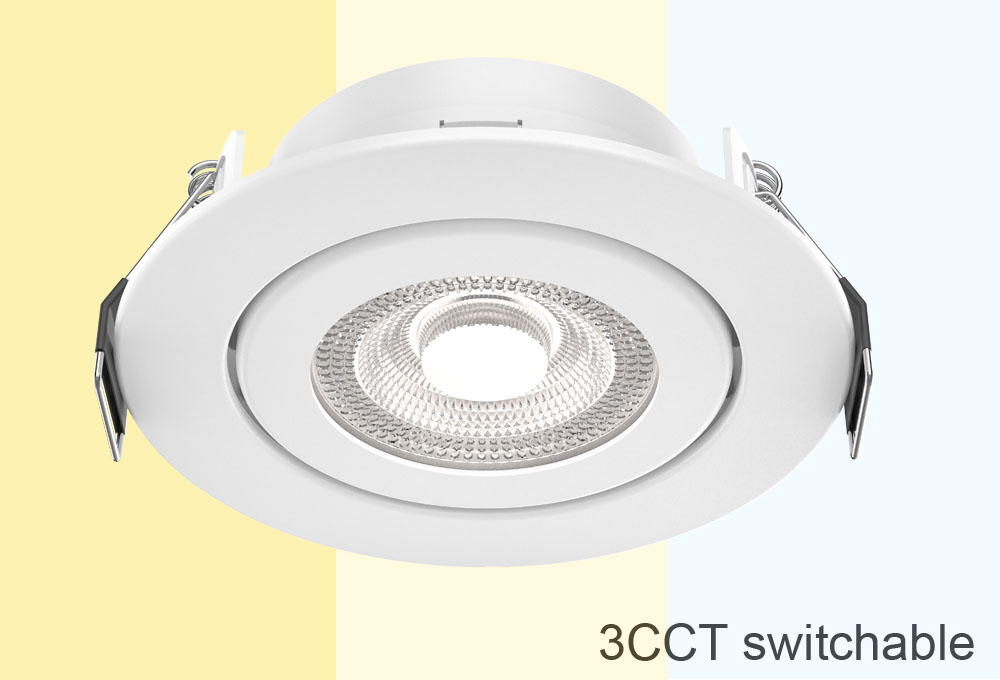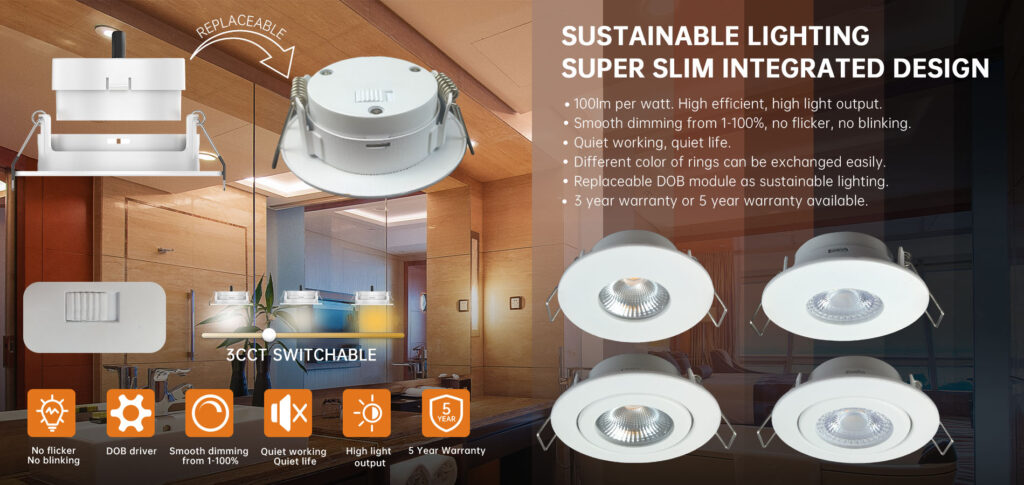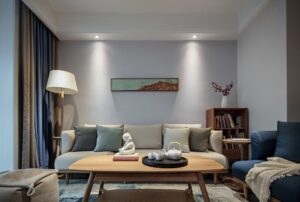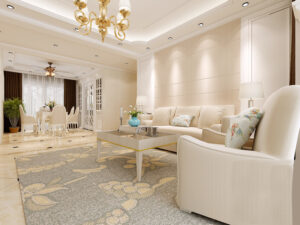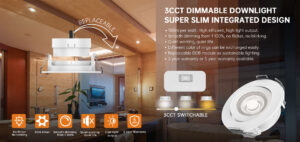Choosing the right light color temperature (CCT) for your rooms can significantly impact the ambiance, functionality, and overall experience of a space. This guide will help you understand CCT, its benefits, and how to select the appropriate temperature for different environments.
What’s Light Color Temperature (CCT)?
Color temperature, often referred to as Correlated Color Temperature (CCT), describes the perceived color of light emitted from a light source such as downlight, spotlight, track light etc. This measurement uses the Kelvin (K) scale to compare the light’s color to that of a theoretical “black body” radiator heated to that temperature. A lower CCT value (generally below 3200K) signifies a “warmer” light appearance, characterized by yellow and red tones. Conversely, a higher CCT (above 4000K) indicates a “cooler” light, leaning towards blue hues.
CCT is a spectrum from about 2000K to 6500K. Here’s how different CCT ranges affect the feel of a space:
- Warm White (2000K – 3000K): Creates a relaxing and welcoming atmosphere, much like the soft glow of candlelight or a sunrise.
- Neutral White or Daylight (3500K – 4100K): Provides a balanced and natural-looking light, similar to daylight.
- Cool White (5000K – 6500K): Offers a bright and energizing light, comparable to the midday sun.
For instance, the familiar light from incandescent bulbs usually falls around 2700K, while daylight LEDs can have CCT values as high as 6500K.
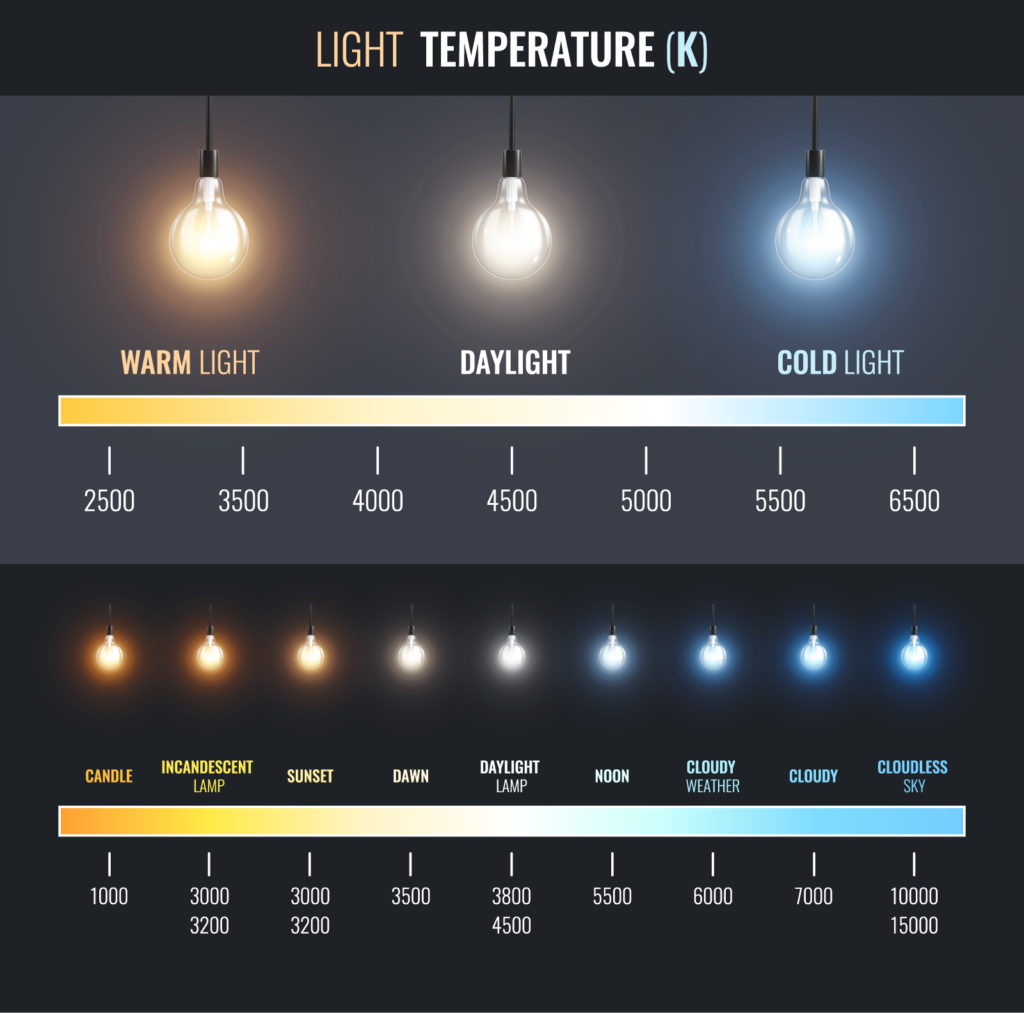
How Does Light Color Temperature (CCT) Work?
The concept of color temperature is deeply rooted in the physics of light emission. It’s based on the principle that when a theoretical object, known as a black body radiator, is heated to increasingly high temperatures, it begins to emit light. Initially, this light appears as a warm, reddish hue. However, as the temperature continues to rise, the emitted light gradually shifts through a spectrum of colors, eventually reaching a point where it appears white, and then progressing towards cooler, bluer tones.
To illustrate this phenomenon, consider a few familiar examples: The flame of a candle, burning at a relatively low temperature of approximately 1500 Kelvin (K), emits a distinctive warm orange glow, creating a cozy and intimate ambiance. In contrast, midday sunlight, which registers around 5500K, produces a much brighter and more neutral white light, ideal for illuminating spaces with clarity and vibrancy. Furthermore, on a cloudy day, the color temperature of the sky can soar to 6500K or even higher, resulting in the cool, blue-tinged light often associated with overcast conditions.
This principle is incredibly important in the field of lighting design, as it provides a framework for understanding how artificial lighting can be manipulated to mimic the qualities of natural light at different times of the day. By measuring the color of light emitted by a particular source and comparing it to the color emitted by a black body radiator at a specific temperature, we can assign a Correlated Color Temperature (CCT) value to that light source. As the temperature increases, the light transitions from the warmer end of the spectrum (reds and oranges) to the cooler end (blues). This relationship empowers users to make informed decisions when selecting lighting solutions that align with their specific needs and preferences.
For instance, lower CCT values from a light resource like downlight or spotlight, typically below 3000K, evoke a sense of warmth, relaxation, and intimacy. These light sources are often favored in residential settings such as bedrooms and living rooms, where the goal is to create a comfortable and inviting atmosphere. Conversely, higher CCT values, generally above 4000K, promote alertness, concentration, and productivity. This makes them well-suited for task-oriented environments such as offices, studios, and kitchens, where clear and focused illumination is essential. Ultimately, a solid grasp of color temperature and its implications enables individuals to curate lighting schemes that not only enhance the functionality of their spaces but also contribute to their overall well-being and aesthetic enjoyment.
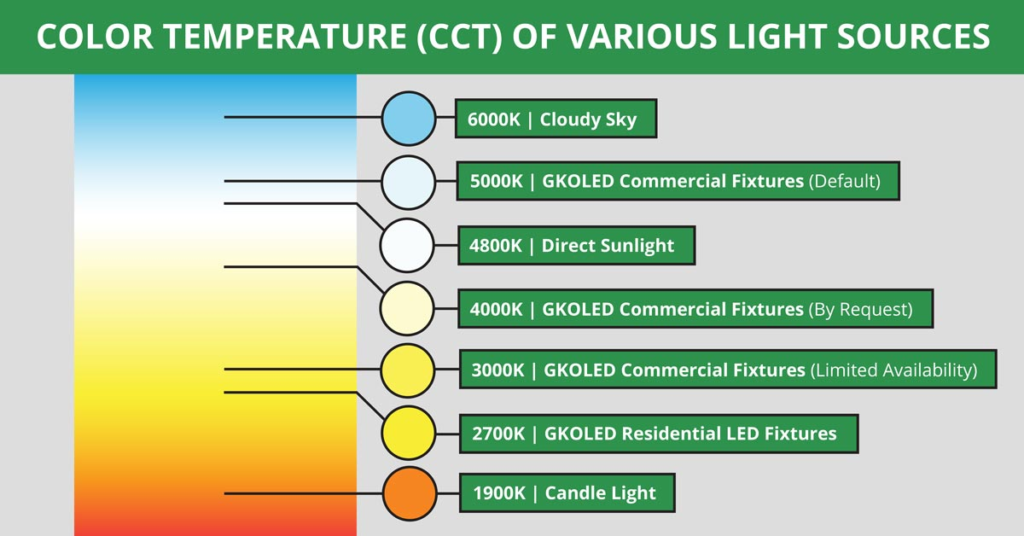
The Right Color Temperature Good for Human Behavior
Selecting the appropriate Correlated Color Temperature (CCT) for lighting can yield significant benefits across various environments. The influence of CCT extends to mood regulation, productivity enhancement, and the overall aesthetic appeal of a space.
For instance, in residential settings, warm lighting with lower CCT values promotes relaxation and comfort, making it ideal for living rooms and bedrooms.
Conversely, cooler light temperatures are known to increase alertness and focus, which is particularly advantageous in workplace environments where concentration is key. Research indicates that cooler light settings can mitigate fatigue and improve overall productivity in office environments.
Furthermore, CCT plays a crucial role in accentuating design elements within both homes and businesses. By carefully choosing color temperatures, one can create specific atmospheres, whether it’s a welcoming and cozy ambiance or a professional and energizing setting
The Best Practices for Choosing CCT in Different Rooms
Selecting the appropriate correlated color temperature (CCT) is essential for optimizing the functionality and ambiance of each room in your home. CCT, measured in Kelvin, affects how warm (yellow) or cool (blue) the light appears. By understanding the specific needs and activities within each space, you can tailor your lighting to enhance comfort, productivity, and overall well-being.
Living Room
Recommended CCT: 2700K – 3000K
Purpose: As a hub for relaxation and social interaction, the living room benefits from warmer light temperatures, which foster a cozy and inviting atmosphere ideal for family gatherings or quiet evenings.
Tips: Utilize lamps equipped with dimmers, allowing you to adjust the dimmable downlight intensity based on the time of day or the activity, providing flexibility and control.
Incorporate accent lighting to highlight artwork or architectural features, adding depth and visual interest while maintaining a warm, ambient glow throughout the space.
Bedroom
Recommended CCT: 2700K – 3000K
Purpose: The bedroom should serve as a sanctuary for relaxation and restful sleep. Warmer light tones mimic the gentle light of sunset, signaling the body to wind down and prepare for sleep.
Tips: Install bedside wall light or table light with soft, warm light for reading, providing adequate illumination without overwhelming brightness that can disrupt the calming environment.
Avoid harsh white lights, as they can interfere with the body’s natural sleep-wake cycle and hinder relaxation.
Kitchen
Recommended CCT: 3000K – 4000K
Purpose: Kitchens require bright, clear lighting for tasks such as cooking and food preparation. A neutral white light from kitchen under cabinet downlight is failproof. Cooler temperatures improve visibility and focus, ensuring safety and efficiency in the kitchen.
Tips: Implement under-cabinet lighting to directly illuminate work surfaces, eliminating shadows and enhancing visibility during meal preparation.
Incorporate adjustable lighting options, allowing you to switch between warmer tones during dining and cooler tones while cooking, catering to different needs and preferences.
Bathroom
Recommended CCT: 3000K – 4000K
Purpose: Bathrooms require a balance of warmth and clarity for grooming tasks. A neutral to cool white light provides sufficient illumination without being too harsh, ensuring accurate color rendering and visibility.
Tips: Use vanity lights around mirrors that offer even illumination, minimizing shadows and ensuring accurate reflection for grooming and makeup application.
Consider frosted fixtures to diffuse light softly, reducing glare and creating a more comfortable and flattering lighting environment while maintaining adequate brightness. Except CCT, we should take waterproof rating into consideration. we should choose waterproof downlight, spotlights or other lights with IP44 at least or IP65 for bathroom
Home Office
Recommended CCT: 4000K – 6500K
Purpose: A home office should foster concentration and productivity. Mimicking natural daylight, cooler temperatures help reduce eye strain and fatigue during long working hours.
Tips: Use task lighting with adjustable color temperatures to suit different times of day or specific tasks, allowing you to customize the lighting to optimize focus and comfort. Besides, if we are going to spend a lot of time in our home office to work or study. We should choose some lights with less blue light and low UGR(blow UGR 16) to protect our eyes.
Combine overhead lighting with desk lamps for optimal illumination, ensuring adequate light coverage and minimizing shadows in the workspace.
Dining Room
Recommended CCT: 2700K – 3500K
Purpose: The dining room should create a welcoming atmosphere that enhances the dining experience. Warm to neutral tones can stimulate appetite and conversation, fostering a sense of conviviality.
Tips: Utilize pendant lights or chandeliers with dimmers to adjust the mood during meals, creating a more intimate and inviting ambiance.
Incorporate candlelight or soft table lamps for an intimate setting, adding warmth and charm to the dining experience.
Hallways and Entryways
Recommended CCT: 2700K – 3500K
Purpose: These areas should feel welcoming yet functional. Warmer tones can create a friendly atmosphere while ensuring visibility for safety.
Tips: Employ wall sconces or recessed lighting to provide sufficient illumination without overwhelming brightness, ensuring safe passage and a welcoming ambiance.
Consider motion-sensor lights for convenience, providing hands-free illumination and enhancing energy efficiency in these transitional spaces.B
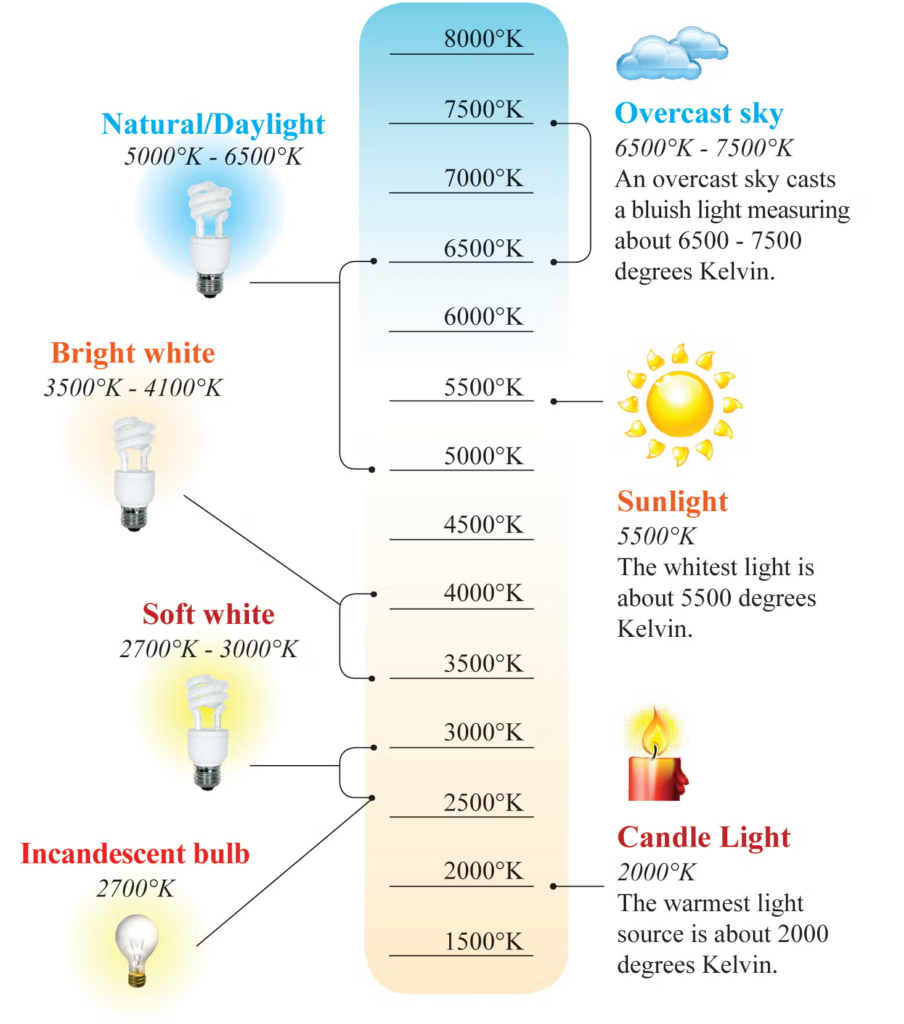
Additional Considerations
Dimmable Lighting: Utilizing dimmable lights allows for adjustable light intensity, enabling you to modify the ambiance to suit different activities and times of day.
Color Rendering Index (CRI): Aim for light sources with a CRI of 80 or higher to ensure accurate color representation, which is especially important in areas like kitchens and bathrooms.
Personal Preference: While these guidelines provide a starting point, personal comfort and aesthetic preferences should ultimately guide your lighting choices.
The Convenience of CCT Swicthable Products
Choosing the right lamp can be challenging, often leading to later replacements. The Radians lamp with adjustable color temperature perfectly addresses this issue. Avoid the worry of selecting the wrong lamp. Radians provides a versatile lighting solution that adapts to your needs, saving you time and money.
Radians’ CCT adjustable downlights offer several key features:
- 3CCT Switchable: 2700K-3200K-4000K or 3000K-4000K-5700K
- High Lumen Output: Up to 100 lumens per watt.
- Smooth Dimming: 0-100% triac dim, smooth dimming, flicker-free.
- Silent Performance: Operates without noise.
- Sustainable Design: Replaceable, driverless (integrated built-in driver) module.
- Long Lifespan: Backed by a 5-year warranty.
Advantages for Dealers and Customers
For dealers, the CCT adjustable design reduces inventory needs by eliminating the necessity to stock every color temperature. Customers benefit from simplified design decisions; easily switch the color temperature even after installation if needed.
Additional Lighting Solutions
Beyond adjustable color temperature dimming downlights, Radians offers waterproof downlights, anti-glare downlights, adjustable color temperature panel lights, back-lit panel lights, and adjustable color temperature track lights.
Radians, established in 2019, specializes in the design, production, sales, and marketing of downlights, track light, panel light and etc. Radians represents unique design, quality, and professional service, infusing skill and passion into every lighting product. Most products are CE and RoHS certified. The goal is to develop and manufacture beautiful, efficient lamps.
Conclusion
Selecting the appropriate light color temperature (CCT) for each room enhances a home’s functionality and aesthetic. Understanding each space’s purpose and how different light temperatures affect mood and activity allows you to create a comfortable and inviting environment that supports your lifestyle.
FAQs
Q: Can I mix different CCTs in one room?
A: Yes! Layer warm ambient lighting with cool task lights for balance.
Q: What CCT is best for eye health?
A: 2700K–3000K at night reduces blue light exposure, aiding sleep.
Q: Does CCT affect energy efficiency?
A: No—efficiency depends on bulb type (LED vs. incandescent), not Kelvin.

